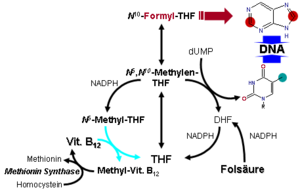Vitamin B12
Vitamin B12, also called cobalamin, is a water-soluble vitamin that has a key role in the normal functioning of the brain and nervous system via the synthesis of myelin (myelinogenesis), and the formation of red blood cells. It is one of eight B vitamins. It is involved in the metabolism of every cell of the human body, especially affecting DNA synthesis, fatty acid and amino acid metabolism.
No fungi, plants, or animals (including humans) are capable of producing vitamin B12. Only bacteria and archaea have the enzymes needed for its synthesis. Some substantial sources of B12 include animal products (shellfish, meat), fortified food products, and dietary supplements. B12 is the largest and most structurally complicated vitamin and can be produced industrially through bacterial fermentation synthesis, typically used to manufacture B12 for fortified foods and supplements. It can also be produced synthetically via vitamin B12 total synthesis.
Vitamin B12 consists of a class of chemically related compounds (vitamers), all of which show pharmacological activity. It contains the biochemically rare element cobalt (chemical symbol Co) positioned in the center of a planar tetra-pyrrole ring called a corrin ring. The vitamer is produced by bacteria as hydroxocobalamin, but conversion between different forms of the vitamin occurs in the body after consumption.
Vitamin B12 was discovered as a result of its relationship to the disease pernicious anemia, an autoimmune disease in which parietal cells of the stomach responsible for secreting intrinsic factor are destroyed; these cells are also responsible for secreting acid in the stomach. Because intrinsic factor is crucial for the normal absorption of B12, its lack in the presence of pernicious anemia causes a vitamin B12 deficiency. Many other subtler kinds of vitamin B12 deficiency and their biochemical effects have since been made clear.Due to impairment of vitamin B12 absorption during aging, people over age 60 are at risk of deficiency.
Structure;-
Properties:-
1.Geometry-Octahedral
2.d6 system(t2g6 eg0),Low spin complexes
3.It is diamagnetic nature
4.Red coloure
5.Natural organometallic compound
6.4 co-ordination sites are occupied by N-atom of corrin ring ,5th atom of imidazole,6th-cyanide ligand so it is also known as Cyano-Cobalamin
Mechanism of action

Metabolism of folic acid. The role of Vitamin B12 is seen at bottom-left.
Vitamin B12 functions as a coenzyme, meaning that its presence is required for enzyme-catalyzed reactions.
Three types of enzymes:
Rearrangements in which a hydrogen atom is directly transferred between two adjacent atoms with concomitant exchange of the second substituent, X, which may be a carbon atom with substituents, an oxygen atom of an alcohol, or an amine. These use the adoB12 (adenosylcobalamin) form of the vitamin.
Methyl (–CH3) group transfers between two molecules. These use MeB12 (methylcobalamin) form of the vitamin.




Comments
Post a Comment